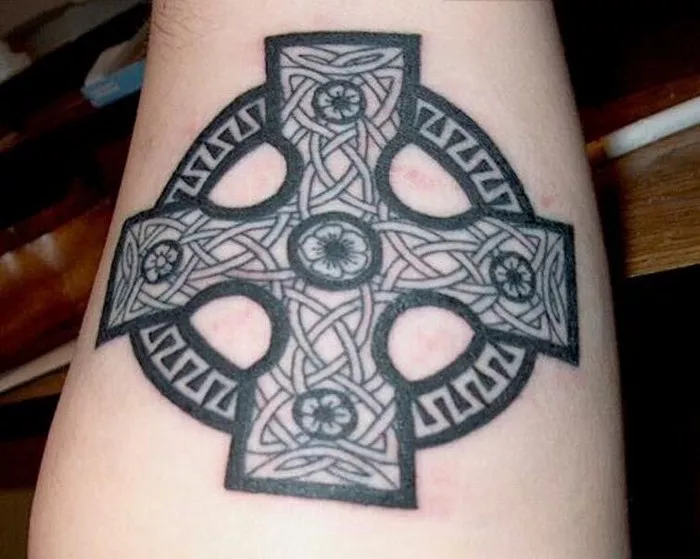Tattoos have long served as a means of personal expression, a canvas upon which individuals imprint their beliefs, experiences, and cultural affiliations. Among the myriad designs adorning human skin, the Celtic cross stands out as a symbol steeped in rich history and profound significance. In this comprehensive exploration, we delve into the origins, symbolism, and cultural resonance of the Celtic cross tattoo, shedding light on its enduring allure and timeless appeal.
Origins of the Celtic Cross: A Tapestry of History and Tradition
To understand the significance of the Celtic cross tattoo, one must first grasp the origins of the symbol itself. The Celtic cross, characterized by its distinctive ring encircling the intersection of its vertical and horizontal arms, traces its roots back to the early Middle Ages in the British Isles, particularly Ireland and Scotland. Originally carved in stone and wood by Celtic artisans, these crosses served as markers of sacred sites, memorializing significant events or honoring revered individuals.
The precise origins of the Celtic cross are shrouded in the mists of time, with theories ranging from its adaptation of earlier pagan symbols to its integration of Christian iconography following the spread of Christianity throughout the Celtic lands. Regardless of its exact genesis, the Celtic cross emerged as a potent emblem of cultural identity and spiritual devotion, embodying the synthesis of Celtic pagan beliefs and Christian faith.
Symbolism of the Celtic Cross: Unraveling Layers of Meaning
At its core, the Celtic cross symbolizes the intersection of the earthly and the divine, the material and the spiritual realms. Its four arms, extending outward in cardinal directions, represent the elements of earth, air, fire, and water, symbolizing the fundamental forces of nature and the cyclical rhythms of life and death. The circle surrounding the intersection signifies the eternal cycle of life, death, and rebirth, echoing the Celtic belief in the interconnectedness of all things.
Moreover, the intricate knotwork and interlacing patterns adorning the arms of the Celtic cross are imbued with symbolic significance. These motifs, known as Celtic knots, are symbolic of eternity, infinity, and the interconnectedness of all beings. Each twist and turn of the knot symbolizes the complex tapestry of existence, where past, present, and future intertwine in an unbroken continuum.
In addition to its spiritual connotations, the Celtic cross also carries layers of cultural and historical meaning. For many individuals of Celtic descent, the cross serves as a potent symbol of ancestral pride and cultural heritage, evoking memories of a vibrant and resilient civilization that flourished in the face of adversity.
Celtic Cross Tattoos: Embodying Tradition in Contemporary Art
In recent decades, the Celtic cross has experienced a resurgence in popularity as a motif for tattoos, attracting individuals drawn to its timeless elegance and profound symbolism. For some, a Celtic cross tattoo serves as a tribute to their Celtic roots, a tangible connection to a rich cultural legacy passed down through generations. For others, it represents a spiritual journey, a quest for meaning and enlightenment in an increasingly fragmented world.
The design possibilities for Celtic cross tattoos are as diverse as the individuals who wear them. From intricately detailed depictions adorned with elaborate knotwork to minimalist interpretations featuring clean lines and subtle shading, each tattoo is a unique expression of personal identity and aesthetic sensibility. Some opt for traditional black ink tattoos, while others incorporate vibrant colors to enhance the visual impact of the design.
Interpreting Celtic Cross Tattoos: A Personal Journey of Discovery
The beauty of Celtic cross tattoos lies not only in their aesthetic appeal but also in the depth of meaning they hold for those who wear them. Each tattoo is a personal statement, a reflection of the wearer’s beliefs, values, and life experiences. For some, the Celtic cross serves as a talisman of protection, warding off negative energy and imbuing its bearer with strength and resilience. For others, it is a symbol of faith and spiritual enlightenment, a reminder to strive for balance and harmony in all aspects of life.
Interpreting the meaning of a Celtic cross tattoo is a deeply personal endeavor, shaped by the unique perspective and lived experiences of the individual. While some may view it as a symbol of Christian faith, others may see it as a celebration of Celtic culture and heritage. Ultimately, the true significance of a Celtic cross tattoo lies not in its outward appearance but in the inner journey of self-discovery and self-expression it inspires.
Conclusion
In conclusion, the Celtic cross tattoo represents far more than just a decorative design etched onto the skin. It is a potent symbol of cultural heritage, spiritual devotion, and personal identity, embodying the timeless values of strength, resilience, and interconnectedness. Whether worn as a badge of honor by those of Celtic descent or embraced as a universal symbol of faith and unity, the Celtic cross continues to captivate and inspire individuals around the world, transcending boundaries of time and culture. As we journey through life’s ever-changing landscape, may the Celtic cross serve as a guiding light, illuminating our path with its timeless wisdom and enduring grace.

